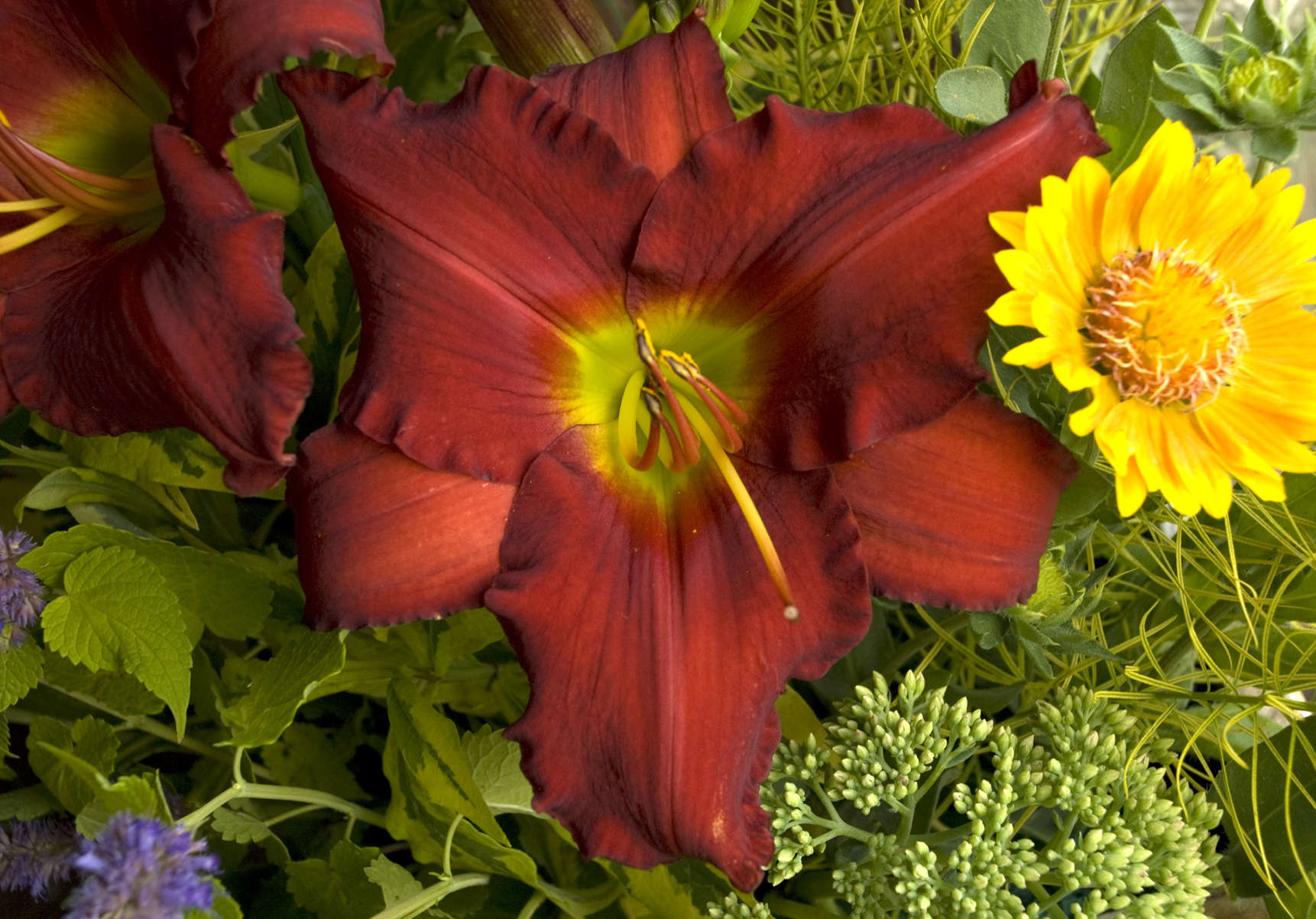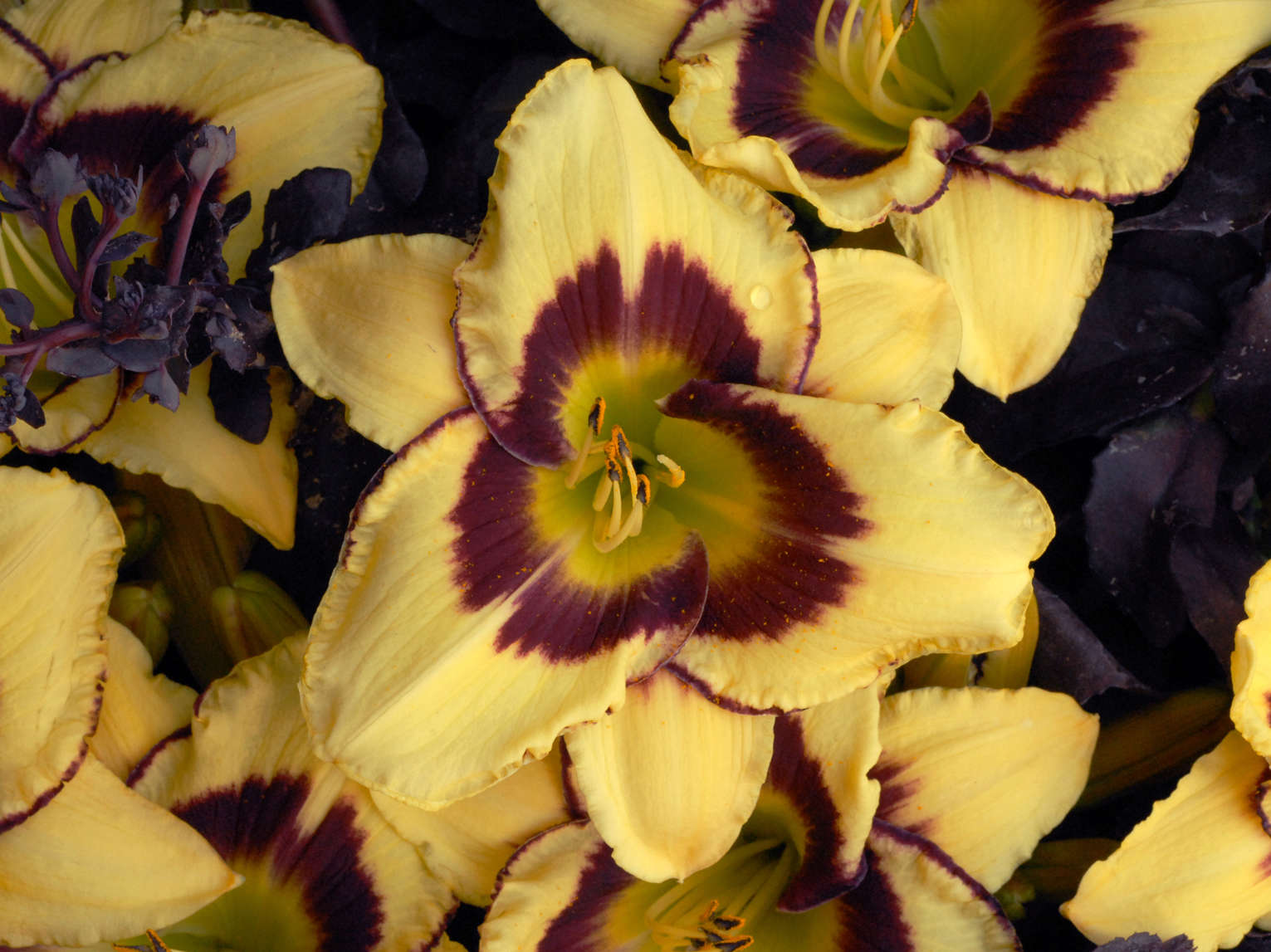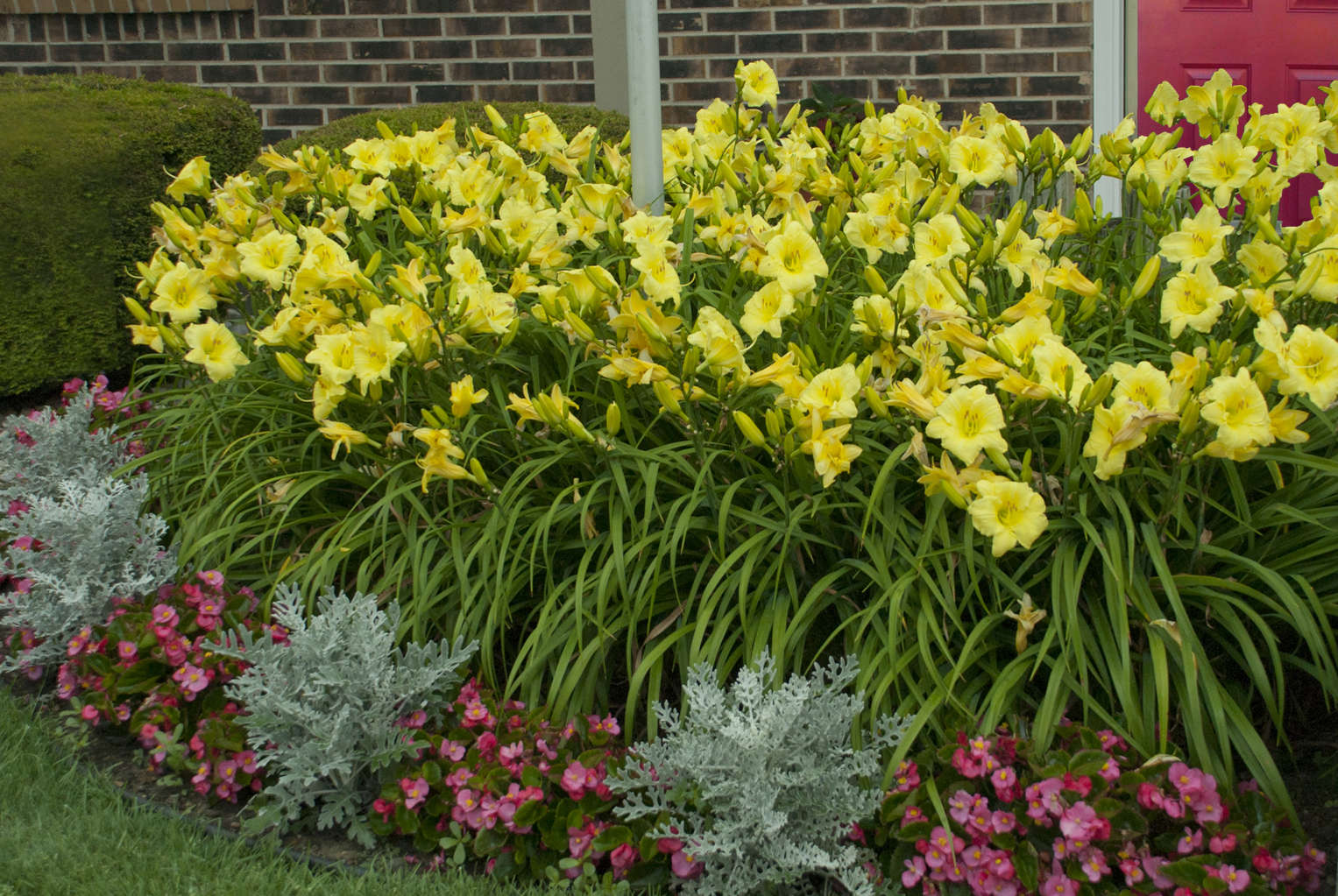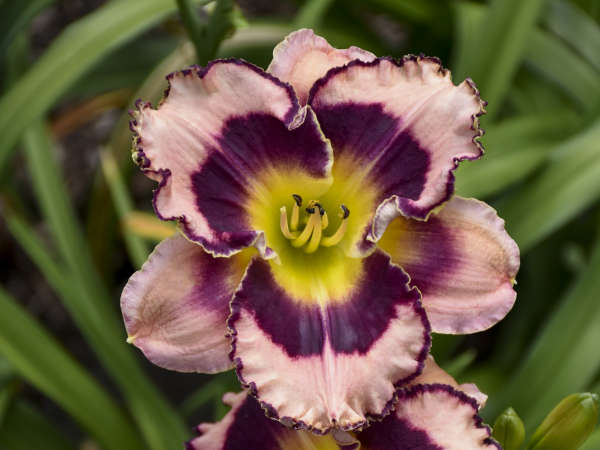Old v. New – The Benefits of Modern Daylily Hybrids
09/02/2014
Out of the 1,000+ varieties of perennials we sell, daylilies stand miles above the rest when it comes to the broad selection of flower colors and forms as well as bloom times. If you think about it, what other kind of perennial offers flower colors in nearly every shade of the rainbow, in multiple forms, with various bloom times throughout the summer, and even reblooms? Perhaps even more incredibly, these complex perennials are easy to grow and deliver a reliable performance year after year.
Over 75,000 varieties of daylilies have been registered since the early 1900s when only yellow, orange, and muted red varieties were available. The push for new hybrids began in the US and England in the 1930s. Since that time, hybridizers have made incredible advancements in flower color, form, bloom time, and foliage. Modern complex daylily hybrids come in a broad spectrum of colors including near-white, pastels, yellows, oranges, pinks, reds, purples, lavenders, and blends. Only pure white and true blue elude hybridizers today, though you can be sure they are working hard to fill that gap.
Old Style Daylily Traits:
- Limited color palette; non-sunfast pigments
- Small flowers with narrow petals
- Flowers of thin substance that don’t hold up under adverse weather conditions
- Limited ruffling, pie crust, and picotee edges
- Flowers held on very tall, thin scapes far above the foliage
- Low bud count of maybe 5-10 per scape; non-branching scapes
- Limited or no reblooming capability
- Foliage that does not remain attractive all season
Modern Daylily Hybrid Traits:
- Broad spectrum of solid flower colors and color patterns; many with sunfast pigments
- Range of flower sizes from small to very large
- Flowers of thick substance that hold up under various weather conditions
- Ornate ruffling, perfect pie crust, and colorful picotee edges
- Flowers held on thick scapes just above the foliage for better proportion
- High bud count of 20-30 or even more per scape; well-branched scapes for even flower placement
- Many reblooming or continuous blooming varieties; high bud count on non-reblooming types
- Foliage that remains attractive all season
Examples: Old v. New Style Daylilies
‘Frans Hals’ (reg.1955) v. ‘Bright Sunset’ (reg.1978) — Though they are of similar color, ‘Bright Sunset’ offers bigger, fragrant flowers held on thicker, heavily budded scapes on a tetraploid plant.
‘Hyperion' (reg.1924) v. ‘Buttered Popcorn’ (reg.1971) — Though both are large flowered yellow daylilies, ‘Buttered Popcorn’ is our best large-flowered reblooming yellow. In our gardens, it blooms first in mid-July and then repeats bloom through the remainder of summer. The plants are loaded with 6inch blossoms and the tall plants provide a terrific focal point in the garden.
‘Happy Returns’ (reg.1986) v. ‘Going Bananas’ PP17164 (reg. by Walters Gardens, Inc. in 2004) — While we may be partial to ‘Going Bananas’ PP17164 since it took us 14 years to introduce, others who have grown this plant will attest to its superior bloom power through the heat of summer, blooming here from early July through the first few frosts of fall. The flowers are about 1inch larger though the plants are similar in height, foliage type, and flower color.
Old style red daylilies v. newer reds such as ‘Duke of Earl’ (reg.1987) and ‘Red Razzmatazz’ (reg. 1991) — Comparatively, newer red daylilies come in a range of vibrant shades of red and many are quite sunfast. Hybridizers have worked to make them more resistant to thrips, a common issue with red daylilies, and to have foliage that remains attractive all season. ‘Duke of Earl’ and ‘Red Razzmatazz’ offer high bud counts and superior flower form with the blooms held just above the foliage.
Daylily Propagation: Why Division is Better
Unlike many of the perennials we sell, daylilies in particular do not respond well to propagation by tissue culture. When propagated in this manner, the plants may vary in color and flowering performance. Since we guarantee true to name plants for our customers, we made the commitment long ago to only propagate our daylilies by field division. We offer only true vegetative stock that will deliver a consistent, uniform performance. In addition, all of our daylilies are free of daylily rust. These are claims that few daylily growers can make, and they set Walters Gardens, Inc. apart from the competition.
Why Choose Modern Premium Daylily Hybrids?
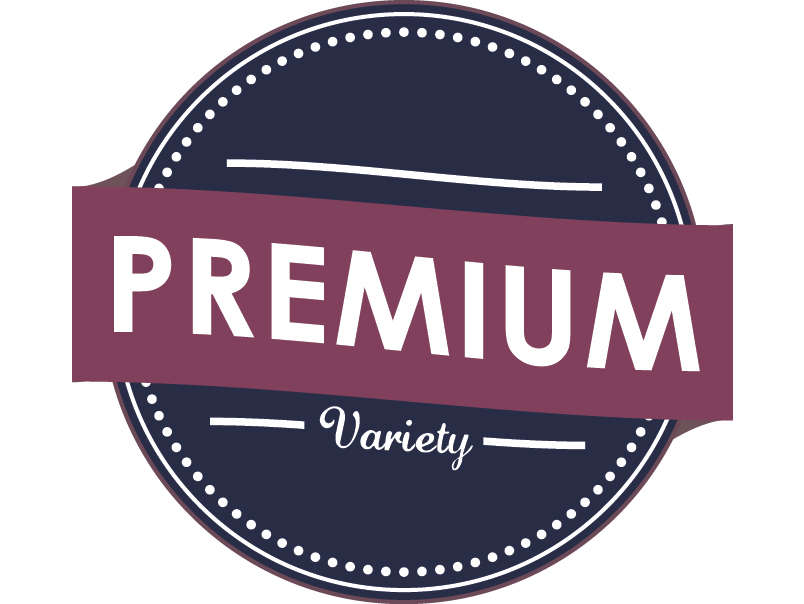
It’s easy to be successful with premium daylilies. Experts agree that they deliver the following benefits:
- Achieve greater impulse appeal with these blossoms of superior form, substance, and sunfast color.
- Gain a prolonged sales window and extended season of color with these heavily budded varieties.
- Deliver reliable performance, even in adverse weather conditions, with blossoms that open consistently.
- Provide customers with healthy looking plants that display pest resistant foliage and vigorous growth all season.
- Rely on plants returning year after year, even in northern gardens, with these completely winter hardy varieties.
Take one look at a mature clump of any premium daylily in the landscape and the difference is obvious. Though these complex hybrids are just as easy to grow as the old style varieties, they provide a much more beautiful display in containers and in the landscape. Their high bud counts, large flowers, pure flower colors and patterns, and attractive foliage set them miles apart from older varieties. Many premium daylilies are rebloomers, and those that are not have very high bud counts resulting in a longer bloom time. They hold a much higher perceived value and are truly worth the cost.
Each premium variety offers something special making it tough to pick a favorite, but if we had to choose…
- Most striking color: ‘Fooled Me’. It’s not surprising that this daylily won the top prize given by the American Hemerocallis Society, the Stout Silver Medal. It’s a knockout!
- Best rebloomer: ‘Apricot Sparkles’ PP13223. Blooms from summer into fall!
- Largest flower: ‘Alabama Jubilee’. Giant 7 inch, red-orange, fragrant blossoms.
- Most unique color: ‘South Seas’. A coral-tangerine blend with a reddish coral band; a one of a kind color.
- Best contrasting eye: ‘El Desperado’. A 60mph plant! This one will stop customers in their tracks!
Cold Hardiness in Daylilies
As a northern field grower of perennials, daylily hardiness is of utmost concern to us. All of our daylilies are grown in our fields for two years before they are shipped to customers, many of whom are also located in colder climates. Though “fancy face” daylilies are gorgeous, many are not hardy in zones 5 and colder. Many daylilies with evergreen foliage also are not particularly hardy. You can be assured that the daylilies you receive from Walters Gardens, Inc. are hardy varieties that have been grown outdoors in zone 5 for at least two years.
Looking into the Future
The hybridizing team at Walters Gardens, Inc. is working diligently to develop the best new large flowered “fancy face” and reblooming varieties of daylilies. In addition to coming up with our own plant genetics, we are working with hybridizers across the US who are working to develop new colors, flower patterns, intricate picotee edges, and other traits not yet seen in hardy daylilies. We also continue to work with Dr. Darrel Apps whose focus is on introducing the best reblooming varieties as evidenced by his “Returns” and “Early Bird” series. As we work to increase our stock of our future varieties by division, we eagerly await the year when we will be able to offer these new and improved hybrids to our customers.
